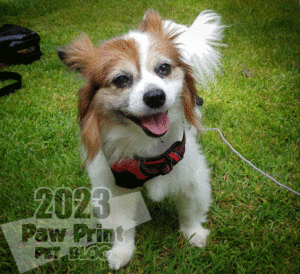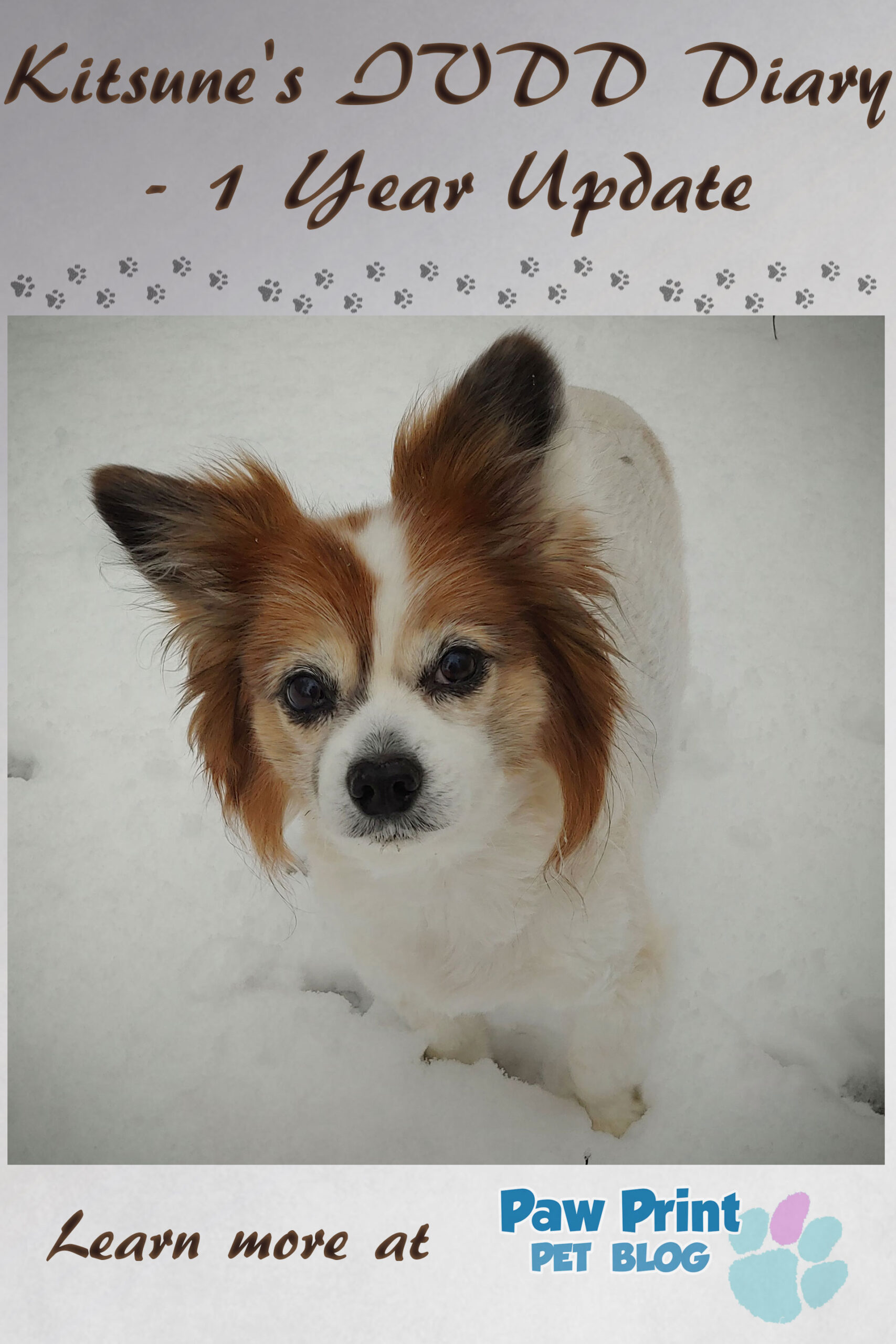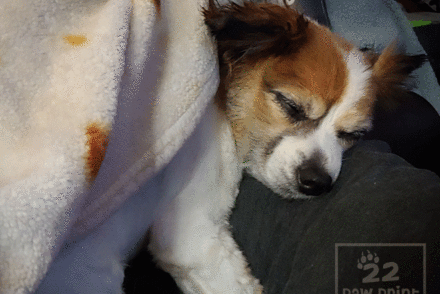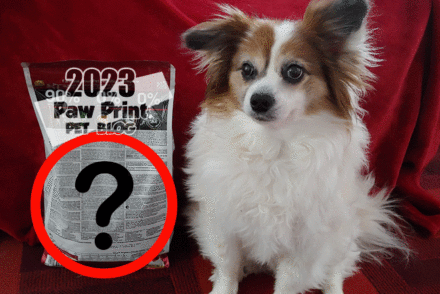On Saturday, September 17th, 2022, my beloved papillon Kitsune was diagnosed with cervical IVDD. Due to a number of factors, including his age, other health concerns, and the fact that he, thankfully, was only diagnosed with stage I – II IVDD, we decided to treat Kit conservatively. In Kit’s case, he never lost mobility but experienced a bit of wobbliness and a lot of pain. His treatment entailed medications to help keep him comfortable and pain-free, as well as to help reduce the swelling around his spine.
This past September marked the one-year point since Kit’s IVDD diagnosis! If you want to look back on his IVDD Diary and see what we dealt with during his recovery, you can do so here:
Post Contents:
Kitsune’s IVDD Recovery Diary:
- Kitsune’s IVDD Recovery Week 1
- Kitsune’s IVDD Recovery Week 2
- Kitsune’s IVDD Recovery Week 3
- Kitsune’s IVDD Recovery Week 4
- Kitsune’s IVDD Recovery Weeks 5 & 6
- Kitsune’s IVDD Recovery Weeks 7 & 8
Our 1-Year Update!
 Although I have posted other, more informational IVDD posts since our week 7 & 8 update posts, I don’t think I’ve sat down and written any other updates since then. By the end of his 8 weeks of recovery time, Kit was fully off of all IVDD-related medications. He was pain-free and we were given the all-clear to slowly start building up his exercise tolerance again.
Although I have posted other, more informational IVDD posts since our week 7 & 8 update posts, I don’t think I’ve sat down and written any other updates since then. By the end of his 8 weeks of recovery time, Kit was fully off of all IVDD-related medications. He was pain-free and we were given the all-clear to slowly start building up his exercise tolerance again.
Thankfully, one year since diagnosis, on the IVDD front Kit has been doing well! In the past year (and 2 months) he hasn’t had any additional IVDD flare-ups. His mobility is pretty normal, especially for an almost 15-year-old dog who also has arthritis. Since his IVDD diagnosis, once in a great while I’ll notice him miss a step with one of his front legs. But it doesn’t happen that often and isn’t anything that holds him back any.
Our IVDD Precautions
For awhile I gave Kit a supplement that I was hoping would help prevent another IVDD flare up. I did end up taking him off of it, however, and haven’t noticed any differences one way or the other since doing so.
We try to avoid allowing Kit to do things that will put too much impact on his back/neck/spine. That includes going up and down the stairs, and jumping on and (especially) off of furniture. It helps that Kit is such a smart cookie! I quickly trained him to “ask” for help getting on or off the furniture or up and down the stairs. Thankfully he’s a small dog, so I have no problem lifting him as needed.
Speaking of being a small dog. A big part of (hopefully) avoiding another instance of IVDD has been helping Kit to loose weight. He was on steroids as part of his IVDD treatment which, as it turned out, really didn’t agree with him. Among other side effects he did end up gaining weight during his recovery. However, he’s lost 2lbs over the last 6 months! I know that doesn’t sound like a lot, but it’s a lot for a small dog. That’s 9% of his body weight! I have to admit I was quite proud during his last vet visit when the vet didn’t need to spend time scolding us for having an overweight dog.
What About Exercise?
Since Kit’s IVDD diagnosis I’ve spoken with quite a few other IVDD dog owners and experts. Some of them seem to severely limit their dog’s exercise/activity after IVDD, while others pretty much return to life as usual. After talking a lot with Kit’s vet, I decided that I didn’t want to let the potential of a future IVDD flare take away from Kit’s enjoyment of life. He loves spending time outside, exploring the woods, wrestling with his brother. And, for the most part, we still allow him to do all those things. I’m more careful about what types of trails we take him out on during walks. These days, we try to stick to flatter trails that don’t have a lot of logs/rocks/etc. that Kit would have to jump or scramble over. But, with a few minor restrictions, we do still allow Kit to exercise and play.

IVDD Is Not a Death Sentence!
Years ago, when less was known about IVDD than today, many dogs who presented to a vet with IVDD symptoms were euthanized. It can be a very painful condition that limits mobility, which can be hard things for dogs and owners alike to deal with. However, a lot more is known about IVDD now, including the fact that many dogs can recover from an IVDD flare and go on to live pain free, happy lives. Researching IVDD can be scary for owners because a lot of the available information is a bit overwhelming, especially when you look up what surgery for IVDD entails and associated costs.
IVDD is not an easy diagnosis to deal with for sure. Even the much cheaper conservative treatment option, what we did with Kit, take weeks of recovery. It’s stressful, especially if you’re anything like me and just hate seeing your dog in any amount of discomfort or pain. But, thankfully, there is hope! With time, patience, a good vet, lots of love, and a little luck, dogs, like my Kitsune, can do very well after a IVDD diagnosis.
Check Out Our Informative IVDD Posts:
What Do You Want to Know About IVDD?
Whether you and your dog are dealing with an IVDD diagnosis yourselves, or you’re just looking to learn more, what types of IVDD related posts would you like to see here in the future? I’m keeping my fingers crossed that Kitsune doesn’t ever have to deal with another IVDD flare up! But I’ve learned a lot about this disease over the past year, and I’m happy to share that information here. If you have any specific questions please feel free to post them in the comments! I will try to either answer them all directly, or else put up a separate post.





No Comments